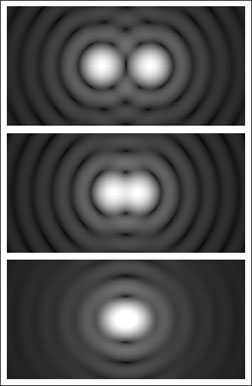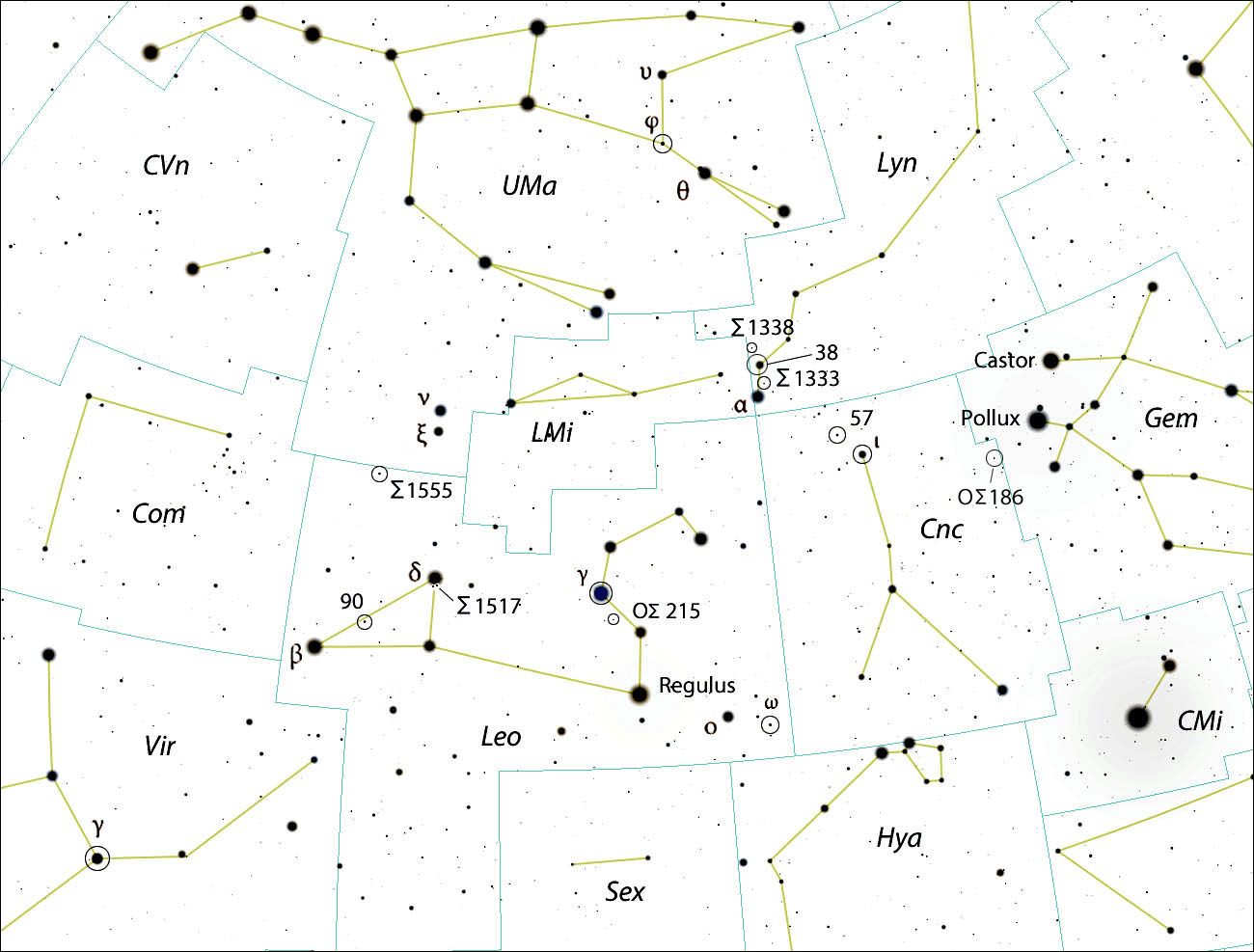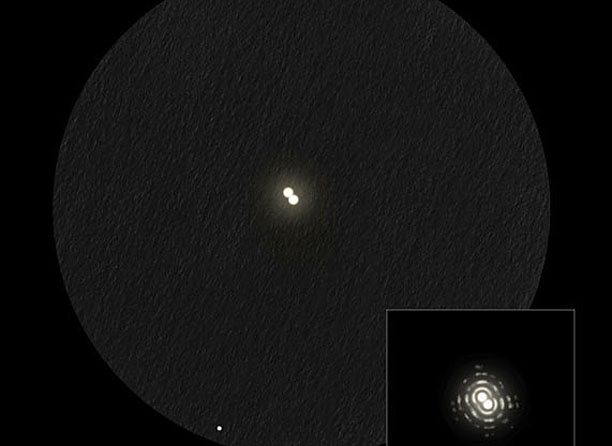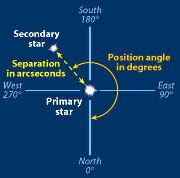Push your telescope to the limit and put your eyes to the test with this series of tight-knit springtime double stars.

Spencer Bliven / Wikimedia Commons / Public Domain
I know, I know. It's not spring yet, but since we'll be talking about pushing the limits of your telescope, I thought it appropriate to nudge the calendar along, too. With the Moon coming back to the evening sky, nebulae and galaxies will soon take a back seat to objects less affected by moonlight and light pollution. Double and multiple stars fit the bill, so I thought it would be fun to provide a graduated series of challenges to test both your telescope's resolution and the keenness of your eye.
First, let's consider the resolution of your telescope. The most stringent test of telescopic resolution uses the criteria of Dawes' limit given by the equation R = 4.56/D, where R is the resolution in arcseconds and D is the telescope's aperture in inches. If using millimeters instead, the formula becomes R = 116/D. Here are a few examples for common telescope apertures given in millimeters/inches (rounded):
60 mm / 2.4 inches — 2.2″
80 mm / 3 inches — 1.5″
100 mm/ 4 inches — 1.2″
150 mm/ 6 inches — 0.8″
200 mm/ 8 inches — 0.6″
250 mm/ 10 inches — 0.5″
320 mm/ 12.5 inches — 0.4″
400 mm/ 16 inches — 0.3″
Dawes' limit holds true for stellar pairs consisting of equally bright stars of about magnitude +6, where the diffraction disk, that little white dot surrounded by its quavering diffraction rings, touches its companion's disk. If the stars are much brighter or fainter, and especially if the double is unequal with a considerable difference in brightness between the primary and secondary, the limit will prove next to impossible. Even approaching the limit for your scope requires nights of steady seeing with calm star images along with the application of high magnification, sometimes in excess of 300×.

Map: Bob King, Source: Stellarium
More realistic when it comes to standing at the telescope's side is the Rayleigh Criterion, given by R = 5.5/D (inches) and defined as when the outer edges of the two stars are separated by the width of the first diffraction ring — in other words, the duo is just resolved. Here are the Rayleigh values:
60 mm / 2.4 inches — 2.3″
80 mm / 3 inches — 1.8″
100 mm / 4 inches — 1.4″
150 mm / 6 inches — 0.9″
200 mm / 8 inches — 0.7″
250 mm / 10 inches — 0.55″
320 mm / 12.5 inches — 0.4″
400 mm / 16 inches — 0.35″

Jeremy Perez
Whichever you choose, we've got you covered. Before beginning your star-splitting adventure, allow your optics to thoroughly cool down; otherwise, heat rising from the objective or primary mirror will make stars look like oozing daubs of gooey light. No one wants to bust an eye hammering away on Dawes' limit under those conditions! Nor do you want to push the limit on nights of lesser seeing. Since it's hard to know exactly what nights are best, when you do encounter ideal conditions, set aside some time to tackle a few of these close pairs.

Bob King
I did some double digging and came up with a list of stars in good view in early spring. A few are easy and even particularly beautiful for any aperture, but then we ratchet up (or down?) to under 5 arcseconds, a single arcsecond, and finally, sub-arcsecond pairs.
For the closer pairs, I've tried to select examples with small differences in magnitude between primary and secondary that are relatively bright and easy to find. I also kept them all to one region of the sky, so you wouldn't be hopping all over the place.
Double stars are the jewelry of the sky, and exceptionally close pairs exceedingly so. Tiny beads trembling inside a nest of ever-shifting diffraction rings almost seem alive. Such delicacies await your gaze.
| 14 Double Stars in Order of Decreasing Separation | |||||||||
| Star | R.A. | Dec. | Mag 1 | Mag 2 | Sep. | P.A. | Comments | Scope | |
| ι Cnc | 08h 47m | +28° 46' | 4.2 | 6.6 | 31" | 308° | Spring Albireo! | Any | |
| γ Leo | 10h 20m | +19° 51' | 2.2 | 3.5 | 4.5" | 127° | Stunning, colorful! | 60 mm | |
| 90 Leo | 11h 35m | +16° 48' | 6.0 | 7.3 | 3.3" | 209° | 3rd comp. 63″ SW | 60 mm | |
| 38 Lyn | 09h 19m | +36° 48' | 3.9 | 6.1 | 2.5" | 224° | Wide mag. spread | 80 mm | |
| γ Vir | 12h 42m | –01° 27' | 3.5 | 3.5 | 2.5" | 2° | Easier than 38 Lyn | 60 mm1 | |
| Σ1333 | 09h 18m | +35° 22' | 6.5 | 6.7 | 1.8" | 50° | --------------- | 80 mm | |
| OΣ215 | 10h 16m | +17° 44' | 7.2 | 7.5 | 1.6" | 177° | Slowly widening | 150 mm | |
| 57 Cnc | 08h 54m | +30° 35' | 6.1 | 6.4 | 1.4" | ~316° | Orange, very nice | 100 mm | |
| Σ1338 | 09h 21m | +38° 11' | 7.2 | 7.5 | 1.1" | ~315° | Slowly widening | 150 mm | |
| OΣ186 | 08h 03m | +26° 16' | 7.5 | 8.2 | 0.8" | 73° | --------------- | 150-200 mm | |
| Σ1555 | 11h 36m | +27° 47' | 6.4 | 6.8 | 0.8" | 148° | --------------- | 150-200 mm | |
| ω Leo | 09h 28m | +09° 03' | 5.7 | 7.3 | 0.7" | 103° | Tough one! | 200 mm | |
| Σ1517 | 11h 14m | +20° 08' | 7.5 | 8.0 | 0.6" | 115° | --------------- | 200-250 mm | |
| φUMa | 09h 52m | +54° 04' | 5.3 | 5.4 | 0.45" | ~300° | Equal mags. Ideal! | 250-320 mm | |
| Data are from the Washington Double Star Catalog and Sky Catalog 2000.0, Volume 2. Right ascension and declination are for equinox 2000.0 | |||||||||
Notes:
1. γ Vir reached a minimum separation of 0.4″ in 2006. It's been widening since. The values shown are for 2017. Other double star values are also as current as possible.
Additional resources:
* Washington Double Star Catalog
* Cambridge Double Star Atlas
 13
13








Comments
Stephen-Carroll
March 2, 2017 at 4:52 pm
"Tiny beads trembling inside a nest of ever-shifting diffraction rings..." Nice.
You must be logged in to post a comment.
Bob KingPost Author
March 4, 2017 at 12:30 am
Stephen,
Sounds like you've seen them so before 🙂
You must be logged in to post a comment.
Cpk133
March 4, 2017 at 12:26 pm
Thanks for the list. I really enjoyed the article by Phil Kane in the Sept 2016 issue "Find Your Dawes Limit". I was able to split 51 Aquarii last fall with my C9.25 under excellent seeing conditions. I'm going to take pUMa on for my spring double star challenge!
You must be logged in to post a comment.
Bob KingPost Author
March 4, 2017 at 2:29 pm
Good luck, Cpk! I plan to revisit it as well on the next night of excellent seeing.
You must be logged in to post a comment.
Mark
March 4, 2017 at 3:40 pm
Why do your charts for Dawes limit and Rayleigh Criterion show minutes when it should be seconds?
For example, your chart for Dawes limit shows a limit of 30 seconds (0.5 minute) for a 10" telescope when instead it should be 0.5 seconds.
You must be logged in to post a comment.
Mark
March 4, 2017 at 3:47 pm
Actually, I see the problem. It appears to be the font used and how it appears in different browsers. The charts for Dawes Limit and Rayleigh Criterion use a different font than the chart for the 14 stars. In the Chrome browser, " (seconds) looks like ' (minutes). I noticed that when my post above also shows the minute mark instead of the seconds mark in Chrome. When I view the page in Firefox this problem does not appear. The charts are correct, but strangely do not appear correct in Chrome. Odd.
You must be logged in to post a comment.
Bob KingPost Author
March 4, 2017 at 4:31 pm
Hi Mark,
Well, that is strange. I use a Mac and create the story on Sky & Telescope's WordPress site using Chrome. They were definitely labeled with arc seconds and still appear that way on Chrome when I go to the site. They must have also looked that way to the editor or she would have flagged it. To ensure that the arc second symbol is accurate, I use html coding as per S&T style.
You must be logged in to post a comment.
Mark
March 4, 2017 at 9:30 pm
Hmmm, that is odd.
Here is what the Rayleigh listing looks like on Windows 10 Google Chrome:
http://pixelsby.me/OtherImages/msWrong.jpg
And by comparison, this is what the bottom table (using a different font) looks like on Windows 10 Google Chrome:
http://pixelsby.me/OtherImages/msRight.jpg
I see from the source code that you're definitely using a double-quote (seconds, not minutes). I didn't bother drilling into the css to see what font is actually being used, but apparently Chrome on Windows doesn't display that particular font character correctly.
Anyway, great article. The problem I described isn't your mistake, but instead appears to be a Chrome problem.
You must be logged in to post a comment.
Bob KingPost Author
March 5, 2017 at 11:04 am
Mark,
Am I imagining this or does the Windows 10 arc second font look correct only that the two tick marks are very, very close?
You must be logged in to post a comment.
Mark
March 6, 2017 at 12:24 pm
It's is definitely showing the double-quote character and not the single-quote character. However, when you look at it on the webpage, it look like a thick single quote. That's what prompted my original post above; I thought you were displaying minutes instead of seconds. I'm sure if the single-quote and double-quote were displayed next to each other, the difference in width and thickness would show it's a different character.
Anyway, great article, this is obviously just a problem in the way Chrome on Windows displays that particular font character.
You must be logged in to post a comment.
Graham-Wolf
March 4, 2017 at 7:44 pm
Hi Bob.
Another great article!
However, your list is for folk North of the equator.
Not really a problem though, as we have some beauts of our own down here in the Antipodes.
I can heartily recommend several doubles inside the famous Southern Cross.
But, wait... there's more!
Try Alpha Centauri (hint... get down to Florida, near Cape Canaveral). It's the brightest of the Pointers to the Southern Cross, and is the 3rd brightest star in the entire sky, after Sirius and Canopus.
I lied a little Bob.... Alpha Centauri is actually a triple.... it has an A and B star (similar to our Sun) and a much fainter C star:- Promima Centauri (discovered in 1915). At 4.22 L.Y. it's our closest star other than good old Sol! A and B are located about the diameter of Neptune's orbit apart, and orbit with a period of 80 odd years. Separation gets down to just 4 arcsec. You can split it with a 60mm refractor at ~ 100x, but I've easily done it with a 4 1/2 incher at half that mag. A good test for optical quality in a scope, and always the first double that us "Southerners" ever look up at.
Nice pics in your article too, Bob.
Regards from 46 South, NZ.
Graham W. Wolf.
You must be logged in to post a comment.
Bob KingPost Author
March 5, 2017 at 11:06 am
Hi Graham,
Thanks! Someday I'll do an all-southern sky object piece. I promise! On a vacation to the Caribbean once, I brought a 3-inch scope with me and was finally able to see and split Alpha Centauri -- one of the most beautiful doubles.
You must be logged in to post a comment.
John Van Allen
August 29, 2019 at 11:22 am
I have been observing doubles from here in Santo Domingo for quite a few years and have noticed that some of the best views I have had were in the periods just after sunset and just before sunrise. This morning I watched Alnitak until sunrise and was amazed. Has anybody else noticed this effect?
You must be logged in to post a comment.
You must be logged in to post a comment.